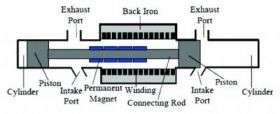A cross-sectional view of the FPLA. Credit: Qingfeng Li
In an advance toward introduction of an amazing new kind of internal combustion engine, researchers in China are reporting development and use of a new and more accurate computer model to assess performance of the so-called free-piston linear alternator (FPLA). Their study of the FPLA, which could provide a low-emission, fuel efficient engine for future hybrid electric vehicles, is scheduled for the Sept. 17 issue of ACS' Energy & Fuels.
Qingfeng Li and colleagues point out that the FPLA has only one moving part and is an engine designed to generate electricity. In the device, a piston in a cylinder shuttles between two combustion chambers.
Permanent magnets on the piston generate electricity by passing through the coils of an alternator centered on the cylinder. The engine can burn a variety of fuels, including natural gas and hydrogen, and seems ideal use in a future world of climate change and possible fossil fuel shortages, they suggest.
Their report describes development of a better computer model to evaluate performance of the FPLA and guide engineers in construction of the engine. Results of their initial simulations showed that the FPLA could accelerate three times faster than other internal combustion engines and burns fuel in ways that minimize air pollution. "It is an environmentally friendly power source for the future," the report concludes.
Article: "Simulation of a Two-stroke, Free-Piston Engine for Electrical Power Generation";
dx.doi.org/10.1021/ef800217k
Source: ACS
























